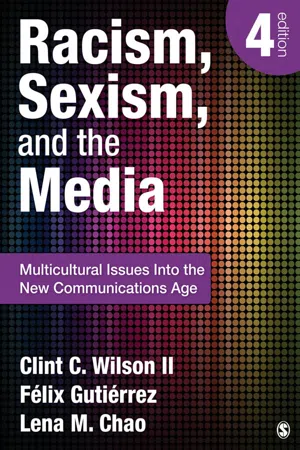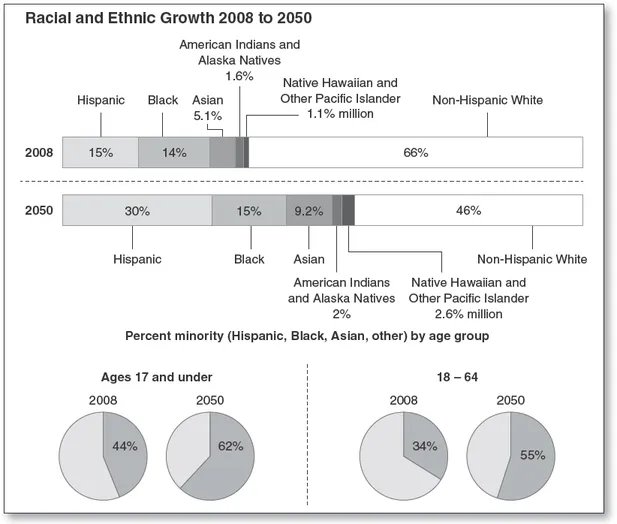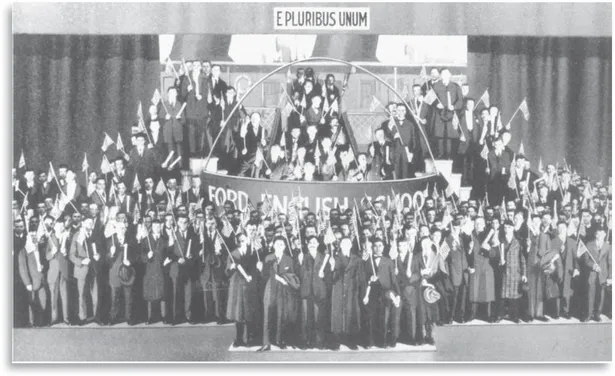![]()
Part I Majority Rules: “Minorities” and
the Media
![]()
1 Demographics
The U.S. Census Bureau made headlines in 2008 when it announced that minorities “are expected to become the majority in 2042.”1 Digital, broadcast, and print news media in the United States and beyond reported the Census Bureau's projection that the people it called Asians, Blacks, Hispanics, American Indians, Alaska Natives, Native Hawaiians, and Other Pacific Islanders would grow to 54% of the U.S. population by 2050.
“Minorities Will Be in Majority,” the Chicago Tribune reported. CNN's website posted a story headlined “Minorities Expected to Be Majority in 2050.” In England The Guardian's headline ran “Ethnic Minorities to Form Majority by 2050.”
The prospect of the United States becoming a majority minority nation in which all people are members of a racial or ethnic minority group also stirred controversy and comments across the nation. Some examined the role of Whites in a nation in which people of other colors collectively composed the majority. In 2009 the blog Digital Journal noted “White people continue to be the largest identifiable group in the U.S. This fact will continue well into the future, regardless of whether or not it's above 50%.”2 Newsweek ran a column by Ellis Cose headlined “Red, Brown, and Blue: America's Color Lines Are Shifting.” A review in The New Yorker asked “Beyond the Pale: Is White the New Black?,” then explored possible changes in White identity and interests as Whites become a minority in a multiracial nation. Author Kelefa Sanneh concluded by observing that the racial change “doesn't mean that white is the new black … and never will be.” But the racial changes from White majority to White minority were seen as portending the “the slow birth of a people” in which Whiteness would become “a work in progress” as Whites developed an awareness of their own history and future in a multiracial nation.3
The projected growth of people of color from different races and cultures in the United States to more than 50% of the population and the Census Bureau's 2011 recognition of Hispanics, also called Latinos, as the largest of those groups also rocked the nation's race relations mind-set. Moving beyond a focus on Black and White, the nation became more aware of its multiracial and multicultural future. This soul searching heightened as racial and ethnic issues across society became more focused, clearer, and sometimes divisive.
Figure 1.1 U.S. Minorities Becoming the Majority
Source: Data from U.S. Census Bureau.
As Figure 1.1 shows, the United States is quickly moving from being a nation that has a White majority and minority groups of different races and ethnicities to one in which no single racial or ethnic group will be in the majority. As this happens, the nation and its media will need to change how people of diverse races and cultures are seen and treated. No one group will be the majority, and everyone in the United States will be a member of a minority group.
Who are the Minorities?
When used in its statistical sense, the term minorities refers to things that are small in number, less than the majority. In the past the term was often applied to people of color in the United States because the total number of Blacks, Latinos, Asians, and Native Americans was smaller than the White majority. Arabs, South Asians, and some other groups were considered so small that they were not counted at all or were placed under one of the existing categories. In the late 20th century the term minorities became a convenient umbrella label under which any group that is not White could be placed.
However, it is a misleading label. It misleads those using and seeing the label to think of people called minorities as small not only in number, but also in importance. In a democratic nation based on majority rule, the label can make the interests and issues raised by minorities seem less important than those of the majority. Increasingly, it is not a statistically accurate term when referring to the racial and ethnic mix of the United States. By the early 21st century, California, Hawaii, New Mexico, and Texas were states in which people of color were in the majority. Analysis of the 2010 census revealed that eight more states were at the “tipping point” of becoming majority minority by 2020: Arizona, Florida, Georgia, Maryland, Mississippi, Nevada, New Jersey, and New York. The same census revealed that 341 of the 3,143 counties (11%) were majority minority, and another 225 were at the tipping point of being so classified by 2020.4
These projections make it clear that the United States will continue to grow as a nation of color through the next generation. In 2010, Asian Americans, Blacks, Latinos, and Native Americans made up 36% of the U.S. population and had accounted for 92% of the nation's population growth since 2000. As this pattern continues, they will continue to grow at a faster rate than non-Hispanic Whites due to immigration, birthrate, and larger average family sizes. As these groups grow in number and percentage of the U.S. population, factors such as intermarriage between groups and generational, gender, and ethnic diversity within each group will make umbrella labels like Asian, Black, Latino, and Native American less useful. At the same time, Arabs, South Asians, Pacific Islanders, and others will become more important as identifiable groups.
The WASP Melting Pot
These changes continue an evolving racial and ethnic mix that has been part of the land that is now the United States since the arrival of the first Europeans in the early 1600s. It is a natural evolution and one that is more inclusive than earlier “Whites preferred” policies that governed the nation's population policies and practices when immigrants came primarily from Europe.
“The region changed from predominantly Native American to predominantly White Anglo-Saxon Protestant (WASP) in large part due to high mortality on the part of the former and high immigration and fertility on the part of the latter group,” wrote population analysts Leon F. Bouvier and Cary B. Davis. “In 1800 close to 20 percent of what, by then, was the United States of America was Black—in large part, the result of high levels of immigration, albeit forced. By 1900, more significant changes had occurred. Blacks were only 10 percent of the population, but among Whites the proportion coming from southern and eastern Europe had grown substantially.”5
As Bouvier and Davis pointed out, the influx of southern and eastern European immigrants challenged the nation's WASP identity early in the 20th century and led to the vision of the United States as a “melting pot” society in which newcomers became Anglo Americans by shedding the culture, language, foods, and identities of their homelands and ancestors. In reality, the melting pot is a high-heat fusion process that melts metals into liquids to force out impurities and unessential elements. The Americanization process was seen as subjecting newcomers to a similar process to disassociate them from their pasts, lose their individual and group identities, then forge a new identity closer to the Anglo American model.
“A popular way of getting hold of the assimilation idea has been to use a metaphor, and by far the most popular metaphor has been that of the ‘melting pot,’ a term introduced in Israel Zangwill's 1908 play of that name,” wrote Hunter College professor Peter Salins. He quoted the play:
There she lies, the great Melting-Pot—Listen! Can't you hear the roaring and the bubbling? … Ah, what a stirring and a seething! Celt and Latin, Slav and Teuton, Greek and Syrian, black and yellow … Jew and Gentile … East and West, and North and South, the palm and the pine, the pole and the equator, the crescent and the cross—how the great Alchemist melts and fuses them with his purifying flame! Here shall they all unite to build the Republic of Man and the Kingdom of God.6
Though the play's text included “Latin … Syrian … black and yellow … the crescent and the cross” in a multiracial and multicultural melting pot, in practice the assimilation process of American society was less inclusive of non-White people and some Europeans such as Jews, Italians, and Irish. Their marginalization was examined in Nathan Glazer and Daniel Patrick Moynihan's 1963 book Beyond the Melting Pot,7 which also examined practices keeping Blacks and Puerto Ricans from fully assimilating into American life.
Nevertheless, the melting pot became an idealized and popular way of describing the assimilation of European immigrants coming to the United States in the early 20th century. Proponents of the model held that those who came to the United States would cast aside the identities, cultures, and languages of home countries such as Germany, Poland, Ireland, or Sweden as they either adopted, or were forced to adopt, the identities, loyalties, customs, and language of their new homeland.
The melting pot theory held that it was necessary to forget, or at least submerge, the culture of a person's roots in order to be allowed to participate in the benefits of the United States. In essence, assimilation to the WASP standard was the price of participation in U.S. society.8 It was thought that within a generation or so the children of European immigrants would “melt” into the working class of the United States and no longer be identifiable by the national origin of their homeland. Many shared the white skin of the British and other earlier European arrivals. By adopting the English language, changing their names to sound more Anglo, and adopting the customs of their new nation, they would appear to be like those who arrived before them.
When most Newcomers to the United States Came from Europe, the Immigrants were Urged to Shed their Home Country Language and Customs and “Melt” into Anglo American Society. The Melting Pot Graduation Ceremony of the Ford English School for Immigrant Automobile Factory Workers in Michigan in 1916 Idealized this with a Steamship Background and Symbolic Melting Pot.
Source: Henry Ford Museum and Greenfield Village.
Leaving the ways of the old country behind and adopting the WASP norms of their new land of opportunity had its advantages for the immigrants. The WASP founders of the United States envisioned a land where people had “inalienable rights … of life, liberty and pursuit of happiness” in a nation where all men were created equal, could participate in electing leaders, and could move up based on merit, hard work, and opportunity.
The melting pot concept was so dominant that the Ford Motor Company in Michigan established the Ford English School in 1913. The goal of the school, which in three years had 2,200 students from 33 nationalities studying under 150 English-speaking Ford workers, was to teach the immigrants to read, write, and speak English in eight months. The graduation ceremony ended with graduates standing on stage alongside a huge symbolic melting pot under the Latin words printed on U.S. currency, “E Pluribus Unum” (From Many, One).
“All commencements were held at the school, and every class had to go into this large cauldron in a foreign costume holding a symbol indicating the country he or she came from,” wrote Boris Sanchez de Lozada and Robert Armoush. “The ceremony ended by emerging students coming out of this cauldron with American clothing an...


